
|
 |
Lockheed Constellation by Earl Swinhart |
 |
 |
 |
 |
 |
|---|---|---|---|---|---|---|---|
 |
 |
 |
 |
 |
|||
 |
|||
|
Of all airliners ever built in America, the checkered career of the "Constellation" has to be amongst the most colorful. A more beautiful airliner was never built, with its sensuously curved fuselage, long legs (both literally and figuratively) and superb streamlining. It simply looked like something futuristic, fast, exciting and beautiful! From its beginnings in the summer of 1939 as the Model 49 "Excalibur A" to the final Model 1649 "Starliner", delivered February 12, 1958, the "Connie" was always described in superlatives such as "highest", "fastest", "best" and "most". (This did not always denote praise however. One of the labels it acquired was "The World's Best Tri-Motor", alluding to early, persistent engine problems.) Along the way, it acquired reputations in the field of smuggling, war, spraying, freight hauling, fine dining and whisking US Presidents to various parts of the globe, in addition to its duties for the major airlines of the world. | |||
| Designed specifically for Transcontinental and Western Airlines (TWA) in 1939, the Lockheed Model 49 "Constellation" (formerly "Excalibur A") was first flown in 1943 and almost immediately commandeered by the US Army Air Force for use as a VIP transport. When first flown as the USAAF C-69, the four engine, 40 ton Connie was faster than the Mitsubishi Zero fighter! |
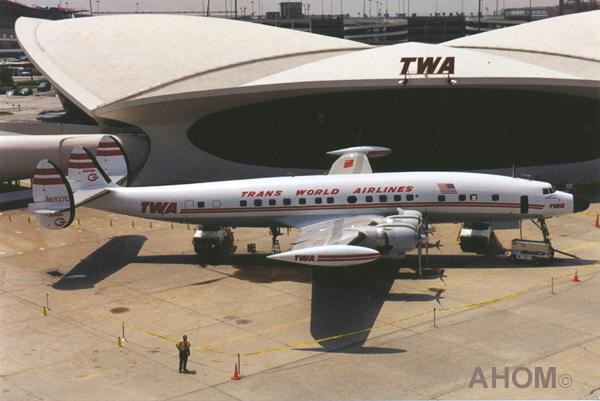
The "Star of America" on display in front of the "Fish Bowl" at TWA's JFK international terminal. The plane was flown in for TWA's 75th Anniversary. Due to the resemblance of a giant aquarium for the viewer outside, this part of the TWA international terminal is commonly referred to as the "Fish Bowl" by TWA's JFK employees. All the Connies coming off the production lines until the end of hostilities in 1945 were bought by the military as the Army model C-69. The various civilian airlines were contracted to fly them for the military. The very troublesome Wright R-3350 Cyclone engine was used—the same engine used in other aircraft such as the Boeing B-29. As a result, the Connie was infected with the same maladies; engine fires, overheating, etc. At one point, Lockheed accused Wright Aeronautical of failure to properly engineer, build and inspect the engine. And rather than consider a Lockheed proposal to switch to Pratt-Whitney R-2800 engines, the Army merely stopped production of the C-69 and waited for the bugs to be worked out of the Wright Cyclone. The evolution of the Connie was slowed several times due to these problems. Another major factor was the low priority assigned to the C-69 by the Army. All this had a negative effect on development of the craft and as a result the Connie finished the war with many of its problems still to be worked out.
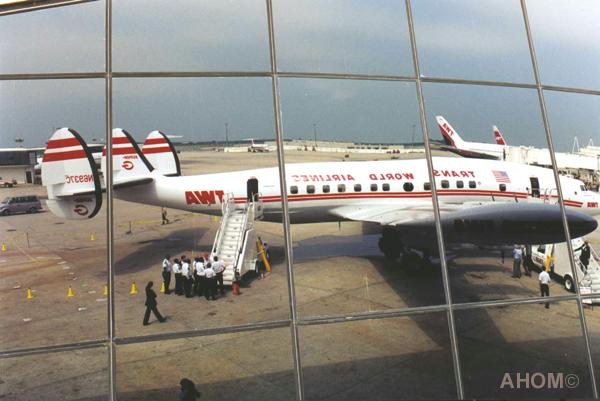
The reflection of the "Star of America" in the window of the "Fish Bowl" at TWA's International terminal at JFK. During its twelve year production run after the war, a total of sixteen civilian model designations were assigned, starting with the original model 49 and progressing in increments of 100 through model 1649 ("1349" was omitted for reasons of superstition). Less than one third ever got off the drawing boards. Some that did had a sub variant designation "-A", "-B" and so on. Quite a few of these sub variants also failed to go into production. Thus, the major civilian Constellation models read: 49, 649, 749A, 1049, 1049C, 1049G, 1049H and 1649A. The models 1049 were officially known as the "Super Constellation", and the 1649A as the "Starliner". The original model 49s had their civilian interiors stripped and a combination of seats and benches installed, among other modifications, in order to be accepted by the Army as C-69s. At the end of WWII, Lockheed bought back from the Army as many as were available, and took those C-69s still on the production line and converted them back to model 49s and began delivering Connies to the airlines of the world. All model 49s were basically "dressed up" C-69s. A rash of incidents in 1945 and 1946 caused this first civilian model of the Connie to be grounded for six weeks in July/August 1946 while the government aviation experts tried to sort out the causes. It was found the aircraft had no basic flaws and it was again pronounced airworthy, though engine problems continued to plague the craft, giving rise to the "Best Tri-Motor" label.

Mechanics standby for engine startup. In fact, one Connie actually did fly as a tri-motor. On June 18, 1946, PanAm’s NC88858 had an engine fire while climbing out over the Atlantic ocean on its way to London. The fire in #4 engine became uncontrollable and eventually burned through the engine mount, causing the entire engine assembly to drop into the Atlantic. NC88858 managed to return to a small emergency field where it was landed without injuries or further mishap. PanAm mechanics determined the aircraft would require factory repair which meant moving the Connie all the way across the continent to Burbank, California. They removed the ragged pieces of the engine nacelle, faired over the gaping hole in the wing with sheets of aluminum and flew the Connie 2,450 miles back to the Lockheed factory with three engines, and looking as if it had been manufactured that way! Many telephone calls were received by radio stations, newspapers, sheriff's offices and military bases about the strange aircraft flying over their cities.
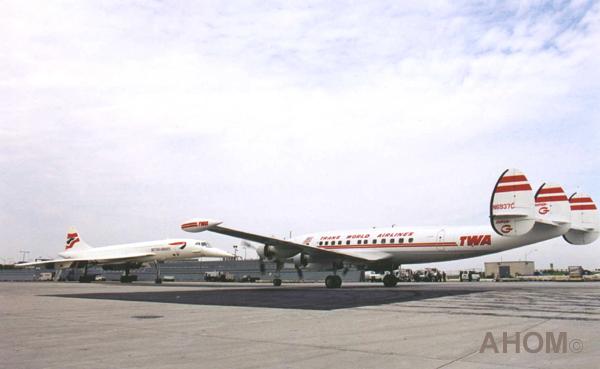
The "Star of America" nose-to-nose with a British Airways Concorde for a photo-op. In late 1946, the model 49 was succeeded by the model 649 Constellation. The model 649 was essentially a "beefed-up" 49, with strengthening in the internal wing structure, landing gear and brakes and a host of other improvements in passenger comfort items such as cabin heating, cooling and ventilation. The 649 was actually the first Connie to be designed without military specifications (or "interference", depending on how one looks at it). At 94,000 lbs (42,638 kg), the 649 represented a 7,500 lb (3,515 kg) increase in maximum takeoff weight and a 1,850 lb (839 kg) increase in payload over the `model 49. The 649s cruise speed was boosted to 327 mph (526 km/h), or 14 mph (23 km/h) faster than the model 49. Dimensions remained the same. The model 749A was designed in response to airline needs for a longer range aircraft. It featured a fuel tank configuration allowing an extra 1,555 gallons (5,886 liters) to be carried. This increased the Connies range with full payload to 2,600 miles (4,184 km) or 310 miles (499 km) further than the 649. The 749A offered a nose-mounted weather radar option which increased overall length from 95’ 3" (29.03 m) to 97’ 4" (29.67 m). Otherwise, dimensions remained the same as the previous two models.
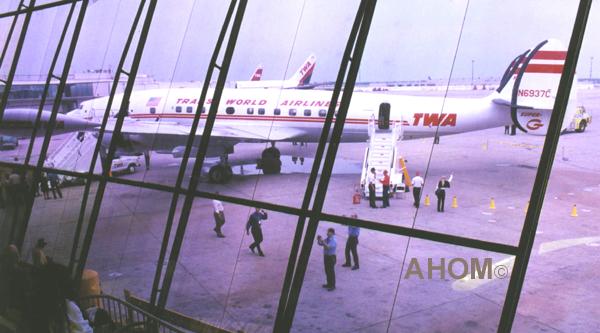
Looking outside from the "Fish Bowl" at TWA's Terminal at JFK. The 1049 Super Constellation was the first of the "Stretched Connies". It was 18’ 4" (5.6 m) longer than previous basic models. The "stretch" was accomplished by splicing an extra 9’ 2" (2.8 m) section into the body just in front, and another just aft of the wing. The 1049 also had more powerful turbo compound R-3350 engines and carried 6,550 gallons (23,974 liters) of fuel with an optional wing center tank capable of carrying an additional 730 gallons (2,763 liters). The 1049 inaugurated non-stop Los Angeles to New York flights on October 19, 1953, though the return trip required a stop in Chicago because the trip took more than the 8 hour limit set by the pilots union. An early problem with the 1049 was again the Wright engines. The exhaust gasses flamed excessively, sometimes sending flames past the trailing edge of the wing. This tended to be more upsetting to the passengers than hazardous, but could also, in rare cases cause a loss of structural integrity in the wing. Once the problems were solved, the 1049 Super Connie went on to become an immensely `successful airliner. When work began on the 1649 in May 1955 it was still called the Super Constellation. Shortly after, it was renamed the "Super Star Constellation" and finally the "Starliner" by Lockheed. Individual airlines had their own names for the plane with TWA referring to their 1649s as "Jetstreams". Whatever the name, the 1649 became the definitive Constellation. It featured a new, longer, narrower wing which provided for nearly double the fuel capacity of the first Connie, to 9,278 gallons (35,121 liters) and well over twice the range with maximum payload, to over 5,400 miles (8,690 km). The Starliner could reach any European capitol non-stop from any major airport in the US. It was the fastest piston engined airliner at ranges over 4,000 miles (6,437 km) ever built.
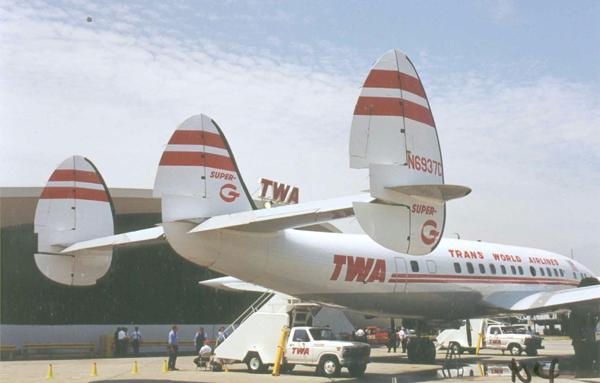
Rear view of the Lockheed Constellation, "Star of America." Creature comforts abounded. The engines were set farther out on the longer wings, which meant less cabin noise. Noise was further reduced with new state of the art sound deadening materials. Cabin temperature control and ventilation were perfected. Seats were fully reclining for comfort on long flights. Everything about the Starliner was impressive; it made a handsome profit for the airlines, passengers flew in total comfort, and it was practically trouble free. But even as the new Connie was taking to the air at Burbank, the death knell was sounding 950 miles to the north. Lockheed built a total of 856 Constellations (331 of these were for the military). An inordinate number were used to smuggle arms, aliens and drugs. More than one Connie has been anchored to the ground and used as a restaurant or cocktail lounge. General Dwight Eisenhower used a C-121A military variant as his personal craft, named "Columbine" and another after he became President, named "Columbine II". General Douglas MacArthur named his Connie the "Bataan". Connies were used extensively for spraying. They were used for secret snooping, with at least one being shot down by hostile gunfire. Constellations were used to carry thousands of tons of food to starving nations. In the end, the Connie was brought down by the fast developing technology of the jet engine, and in particular the Boeing Model 707 jet airliner. Larger, faster, and more profitable aircraft have come and gone in the intervening forty-odd years, but the "Connie" remains to this day one of the most beautiful aircraft ever built. |
| Lockheed Constellation | Specifications: | |||
|---|---|---|---|---|
| Dimensions: | ||||
| Model 049 | Model 749 | Model 1049G | Model 1649 | |
| Wing span: | 123 ft 0 in (37.49 m) | 123 ft 0 in (37.49 m) | 123 ft 5 in (37.62 m) | 150 ft 0 in (45.72 m) |
| Length: | 95 ft 2 in (29.00 m) | 95 ft 2 in (29.00 m) | 113 ft 7 in (34.62 m) | 116 ft 2 in (35.41 m) |
| Height: | 23 ft 8 in (7.21 m) | 23 ft 8 in (7.21 m) | 24 ft 9 in (7.54 m) | 24 ft 9 in (7.54 m) |
| Wing Area: | 1,650 ft² (153.28 m²) | 1,650 ft² (153.28 m²) | 1,654 ft² (153.66 m²) | 1,850 ft² (171.87 m²) |
| Weights: | ||||
| Empty Weight: | 55,345 lbs (25,104 kg) | 58,970 lbs (26,748 kg) | 73,016 lbs (33,120 kg) | 91,645 lbs (41,969 kg) |
| Loaded Weight: | 86,250 lbs (39,122 kg) | 107,000 lbs (48,534 kg) | 137,500 lbs (62,369 kg) | 160,000 lbs (72,575 kg) |
| Performance: | ||||
| Max. Speed: | 329 mph (529 km/h) @ sea level |
358 mph (576 km/h) @ 19,200 ft (5,852 m) |
370 mph (595 km/h) @ 20,000 ft (6,095 m) |
377 mph (606 km/h) @ 18,600 ft (5,669 m) |
| Cruising Speed: | 275 mph (442 km/h) | 327 mph (526 km/h) | 305 mph (491 km/h) | 290 mph (466 km/h) |
| Service Ceiling: | 25,500 ft (7,770 m) | 22,300 ft (6,795 m) | 23,700 ft (7,223 m) | |
| Max Range: | 3,680 miles (5,920 km) with 7,800 lb (3,538 kg) payload |
4,150 miles (6,678 km) with 3,300 lb (1,496 kg) payload |
5,250 miles (8,449 km) with 8,500 lb (3,856 kg) payload |
6,180 miles (9,945 km) with 8,000 lb (3,628 kg) payload |
| Range Max Payload: |
2,290 miles (3,685 km) with 18,400 lb (8,364 kg) payload |
1,760 miles (2,832 km) with 16,300 lb (7,393 kg) payload |
4,140 miles (6,660 km) with 18,300 lb (8,301 kg) payload |
4,940 miles (7,950 km) with 19,500 lb (8,845 kg) payload |
| Powerplant: | Four Wright Cyclone R-3350-745C-18BA-1 engines rated @ 2,200 hp (1,640 kw) each |
Four Wright Cyclone R-3350-749C-18BD-1 engines rated @ 2,500 hp (1,864 kw) each |
Four Wright Cyclone R-3350-972TC-18DA-3 turbo-compound rated @ 3,400 hp (2,535 kw) each |
Four Wright Cyclone R-3350-988TC-18EA-2 turbo-compound rated @ 3,400 hp (2,535 kw) each |
© The Aviation History On-Line Museum.
All rights reserved.
Created November 29, 2001. Updated October 27,2013.